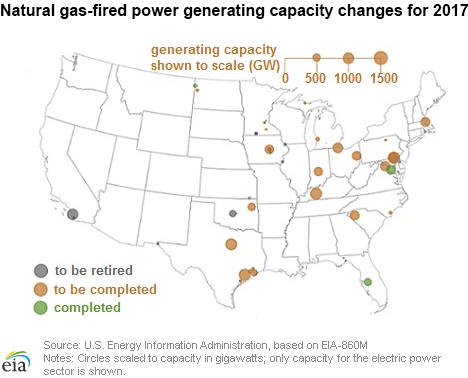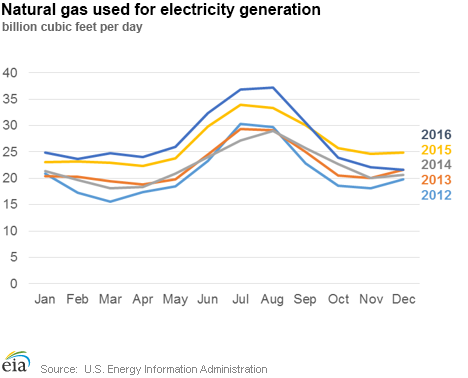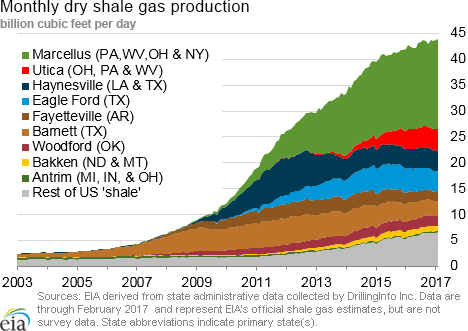In the News:
Thirteen gigawatts of natural gas-fired power generating capacity to be added in 2017
In 2017, 13 gigawatts (GW) of natural gas-fired generating capacity is scheduled to come online in the United States, adding to total end-of-2016 natural gas-fired capacity of 431 GW. More than 90% of these capacity additions are coming from combined-cycle power plants, which offer improved efficiency over simple-cycle combustion turbines or steam turbines alone. So far in 2017, two combined-cycle facilities—over 1 GW in total—have been completed and put into service:
- In a March 14 press release, Competitive Power Ventures announced that the St. Charles Energy Center in Charles County, Maryland, began commercial operations. The new facility can generate 725 megawatts (MW) of power using two gas turbines (205 MW each) and one steam turbine (316 MW).
- The Polk Power Station near Tampa, Florida, completed a 460 MW expansion on January 16, converting four natural gas-fired combustion turbines into a combined-cycle unit.
The two largest combined-cycle power plants to be completed in 2017 are scheduled to be in service ahead of peak summer demand:
- The 1100 MW Paradise combined-cycle plant in Drakesboro, Kentucky, is expected to be completed in April and will replace two of the three older Paradise Fossil coal-fired units.
- The 1000 MW Wildcat Point combined-cycle generating facility in Cecil County, Maryland, is expected to be in service by June 2017. The facility is adjacent to the Rock Springs Generation Facility, a 672 MW natural gas peaking facility.
Total planned retirements of natural gas-fired generating capacity for 2017 are less than 2 GW, with 1.7 GW coming from older steam turbines. In 2016, 8.9 GW of natural gas-fired generating capacity was added, and 4.3 GW was retired (4.1 GW steam turbine), with a net gain of 4.6 GW.
The amount of natural gas consumed for electricity generation has generally increased year over year, while total U.S. net generation across all fuels has remained relatively flat. However, in the fourth quarter 2016, consumption decreased below 2015 levels for the same period as natural gas prices for electricity generators rose. According to the Short-Term Energy Outlook, EIA expects the share of U.S. electricity generation from natural gas to decrease from an average of 34% in 2016 to 32% in 2017 because of an expected 23% increase in the average annual natural gas price for electric generators. In 2018, the natural gas share of generation is expected to rise to 33%.
Overview:
(For the Week Ending Wednesday, March 29, 2017)
- Natural gas spot prices were mixed this report week (Wednesday, March 22 to Wednesday, March 29). The Henry Hub spot price rose from $2.98 per million British thermal units (MMBtu) last Wednesday to $3.03/MMBtu yesterday.
- At the New York Mercantile Exchange (Nymex), the April 2017 contract expired yesterday at $3.175/MMBtu. The May 2017 contract price increased to $3.231/MMBtu, up 16¢ Wednesday to Wednesday.
- Net withdrawals from working gas totaled 43 billion cubic feet (Bcf) for the week ending March 24. Working natural gas stocks are 2,049 Bcf, which is 17% less than the year-ago level and 14% greater than the five-year (2012–16) average for this week.
- The natural gas plant liquids composite price at Mont Belvieu, Texas, fell by 6¢, averaging $5.81/MMBtu for the week ending March 29. The price of ethane and propane fell by 2% and 4%, respectively. The price of natural gasoline, butane, and isobutane rose by 3%, 1%, and 2%, respectively.
- According to Baker Hughes, for the week ending Friday, March 24, the natural gas rig count decreased by 2 to 155. The number of oil-directed rigs rose by 21 to 652. The total rig count increased by 20, and it now stands at 809.
Prices/Supply/Demand:
Prices mixed. This report week (Wednesday, March 22 to Wednesday, March 29), the Henry Hub spot price rose 5¢ from $2.98/MMBtu last Wednesday to $3.03/MMBtu yesterday. At the Chicago Citygate, prices increased 14¢ from $2.89/MMBtu last Wednesday to $3.03/MMBtu yesterday. Prices at PG&E Citygate in Northern California gained 1¢, up from $3.19/MMBtu last Wednesday to $3.20/MMBtu yesterday. The price at SoCal Citygate decreased 6¢ from $3.07/MMBtu last Wednesday to $3.01/MMBtu yesterday.
Northeast prices fall on more seasonable temperatures. At the Algonquin Citygate, which serves Boston-area consumers, prices fell 95¢ from $4.01/MMBtu last Wednesday to $3.06/MMBtu yesterday, after a low of $2.60/MMBtu on Friday. Prices at Algonquin were below those at Henry Hub from last Thursday through Tuesday. At the Transcontinental Pipeline Zone 6 trading point for New York, prices decreased 18¢ from $3.11/MMBtu last Wednesday to $2.93/MMBtu yesterday.
Tennessee Zone 4 Marcellus spot prices decreased 9¢ from $2.77/MMBtu last Wednesday to $2.68/MMBtu yesterday. Prices at Dominion South in northwest Pennsylvania fell 6¢ from $2.82/MMBtu last Wednesday to $2.76/MMBtu yesterday.
April contract expires; May contract rises. At the Nymex, the April 2017 contract expired yesterday at $3.175/MMBtu, up 16¢ from last Wednesday. The May 2017 contract rose to $3.231/MMBtu, up 16¢ from last Wednesday to yesterday. The price of the 12-month strip averaging May 2017 through April 2018 futures contracts climbed 13¢ to $3.379/MMBtu.
Supply falls slightly. According to data from PointLogic, the total supply of natural gas fell by 1% compared with the previous week. Dry natural gas production decreased by roughly 1%, and net imports from Canada decreased by 6%.
Demand falls significantly. Total U.S. consumption of natural gas fell by 10% compared with the previous report week, according to data from PointLogic. Power burn declined by 2% week over week. Industrial sector consumption decreased by 3% week over week. In the residential and commercial sectors, consumption declined by 22% as temperatures moderated from the previous weeks' cold snap in the Northeast. Natural gas exports to Mexico decreased 2%.
U.S. liquefied natural gas (LNG) exports. Natural gas pipeline deliveries to the Sabine Pass liquefaction terminal averaged 1.8 Bcf/d for the report week, 16% lower than in the previous week. Last week, the Federal Energy Regulatory Commission (FERC) issued a letter order authorizing the start of liquefaction and export activities for Train 3. On March 24, FERC issued a letter order granting Sabine Pass Liquefaction, LLC, and Sabine Pass LNG, L.P.'s request to introduce gas and commission the Train 4 fuel gas system. Two vessels (combined LNG-carrying capacity of 7.6 Bcf) departed Sabine Pass last week and two vessels (LNG-carrying capacity of 6.8 Bcf) were loading at the terminal on Wednesday, March 29.
Storage:
A return to warmer temperatures during the storage week results in smaller withdrawals from working gas storage. Despite warming temperatures during the storage week in most of the Lower 48 states, net withdrawals exceeded the five-year average on the week. Net withdrawals from storage totaled 43 Bcf, compared with the five-year (2012–16) average net withdrawal of 27 Bcf and last year's net withdrawals of 19 Bcf during the same week. Withdrawals from working gas totaled 150 Bcf during the previous storage week, as most of the Lower 48 states were significantly colder than normal. Working gas stocks totaled 2,049 Bcf, which is 250 Bcf more than the five-year average and 423 Bcf less than last year at this time.
Withdrawals were larger than normal in the East, Midwest, and South Central salt regions. Withdrawals in the East and Midwest regions totaled 31 and 20 Bcf, compared with their five-year average in each region of 13 and 15 Bcf, respectively. Continued colder than normal temperatures in the East and Midwest likely contributed to the larger than average net withdrawals. The South Central salt region posted a net withdrawal of 6 Bcf, compared with the five-year average net injection of 5 Bcf—an 11 Bcf swing for the storage week.
Working gas stocks remain on pace to end the 2016–17 heating season above 2,000 Bcf for the second year in a row. If working gas stock changes follow the five-year average for the remainder of the heating season, they will total 2,036 Bcf on March 31. Working gas levels topped this threshold at the end of the heating season only two other times, in 2012 and 2016, when working gas totaled 2,473 Bcf and 2,470 Bcf, respectively. Both of those heating seasons were also characterized by warmer-than-normal temperatures and relatively light heating demand for natural gas. So far in 2017, net withdrawals are 19% lower than the five-year average.
Withdrawals are close to market expectations for the week. According to the Bloomberg survey of natural gas analysts, estimates of net withdrawals from natural gas storage ranged from 27 Bcf to 55 Bcf, with a median withdrawal of 43 Bcf. The price of the Nymex futures contract for May 2017 delivery at Henry Hub decreased 3¢/MMBtu to $3.16/MMBtu in 1,454 trades at the release of the
Temperatures are higher than normal in the Lower 48 states, on average, but lower than normal in some key demand areas during the storage report week. Temperatures in the Lower 48 states averaged 48°F, 2°F higher than the normal and 1°F lower than last year at this time. Temperatures were warmer than normal in most areas of the Lower 48 states, outside of the Northeast, Middle and South Atlantic, and parts of the Midwest. In particlar, temperatures were considerably colder than normal in areas of the Lower 48 states where natural gas is an important fuel source for space heating. Temperatures in the New England Census division averaged 33°F, 5°F lower than the normal and 7°F lower than last year at this time, and temperatures in the Middle Atlantic Census division averaged 36°F, 4°F lower than the normal and 7°F lower than last year at this time. Temperatures in the East North Central Census division averaged 38°F, 1°F lower than the normal and 5°F lower than last year at this time.
See also:

| Spot Prices ($/MMBtu) | Thu, 23-Mar |
Fri, 24-Mar |
Mon, 27-Mar |
Tue, 28-Mar |
Wed, 29-Mar |
|---|---|---|---|---|---|
| Henry Hub |
2.93 |
2.92 |
2.95 |
2.93 |
3.03 |
| New York |
2.65 |
2.55 |
2.69 |
2.79 |
2.93 |
| Chicago |
2.88 |
2.87 |
2.92 |
2.94 |
3.03 |
| Cal. Comp. Avg.* |
2.83 |
2.81 |
2.87 |
2.80 |
2.87 |
| Futures ($/MMBtu) | |||||
| April contract | 3.051 |
3.076 |
3.052 |
3.096 |
3.175 |
| May Contract |
3.131 |
3.153 |
3.131 |
3.177 |
3.231 |
| *Avg. of NGI's reported prices for: Malin, PG&E Citygate, and Southern California Border Avg. | |||||
| Source: NGI's Daily Gas Price Index | |||||
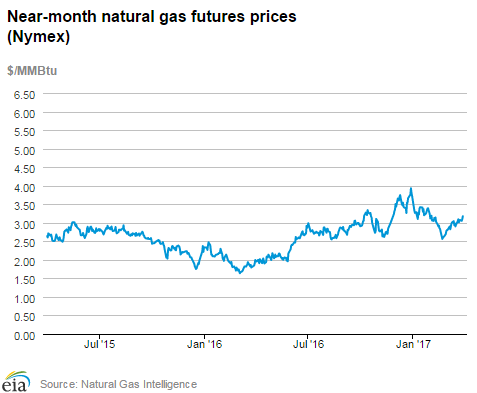
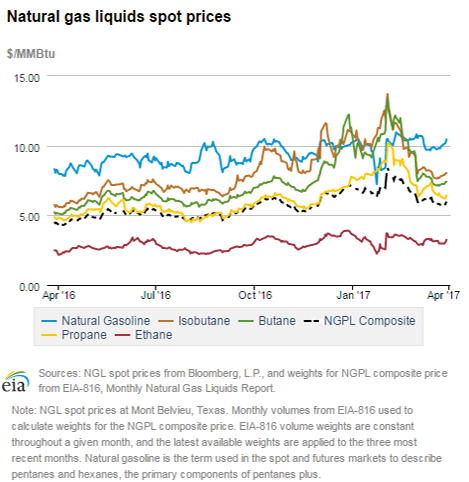
| U.S. natural gas supply - Gas Week: (3/23/17 - 3/29/17) | |||
|---|---|---|---|
Average daily values (Bcf/d): |
|||
this week |
last week |
last year |
|
| Marketed production | 78.3 |
78.7 |
81.4 |
| Dry production | 69.8 |
70.2 |
72.9 |
| Net Canada imports | 5.6 |
5.9 |
4.7 |
| LNG pipeline deliveries | 0.0 |
0.0 |
0.2 |
| Total supply | 75.4 |
76.2 |
77.8 |
|
Source: OPIS PointLogic Energy, an IHS Company | |||
| U.S. natural gas consumption - Gas Week: (3/23/17 - 3/29/17) | |||
|---|---|---|---|
Average daily values (Bcf/d): |
|||
this week |
last week |
last year |
|
| U.S. consumption | 63.8 |
70.8 |
67.3 |
| Power | 21.7 |
22.2 |
22.8 |
| Industrial | 20.9 |
21.5 |
21.2 |
| Residential/commercial | 21.1 |
27.0 |
23.4 |
| Mexico exports | 3.7 |
3.8 |
3.3 |
| Pipeline fuel use/losses | 5.6 |
6.2 |
5.9 |
| LNG pipeline receipts | 1.8 |
2.2 |
0.6 |
| Total demand | 74.9 |
82.9 |
77.1 |
|
Source: OPIS PointLogic Energy, an IHS Company | |||
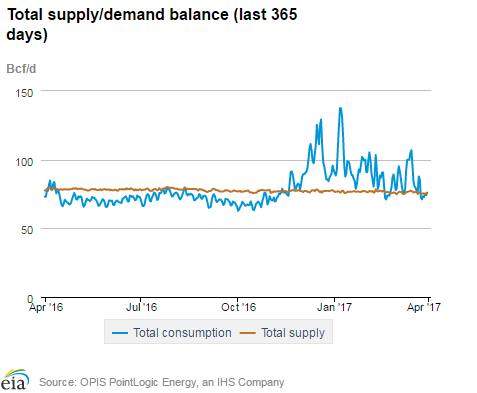
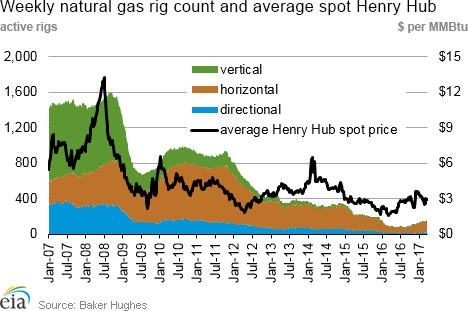
| Rigs | |||
|---|---|---|---|
Fri, March 24, 2017 |
Change from |
||
last week |
last year |
||
| Oil rigs | 652 |
3.3% |
75.3% |
| Natural gas rigs | 155 |
-1.3% |
68.5% |
| Note: Excludes any miscellaneous rigs | |||
| Rig numbers by type | |||
|---|---|---|---|
Fri, March 24, 2017 |
Change from |
||
last week |
last year |
||
| Vertical | 78 |
11.4% |
47.2% |
| Horizontal | 673 |
2.3% |
87.5% |
| Directional | 58 |
-4.9% |
11.5% |
| Source: Baker Hughes Inc. | |||
| Working gas in underground storage | ||||
|---|---|---|---|---|
Stocks billion cubic feet (Bcf) |
||||
| Region | 2017-03-24 |
2017-03-17 |
change |
|
| East | 278 |
309 |
-31 |
|
| Midwest | 486 |
506 |
-20 |
|
| Mountain | 141 |
137 |
4 |
|
| Pacific | 212 |
208 |
4 |
|
| South Central | 932 |
932 |
0 |
|
| Total | 2,049 |
2,092 |
-43 |
|
| Source: U.S. Energy Information Administration | ||||
| Working gas in underground storage | |||||
|---|---|---|---|---|---|
Historical comparisons |
|||||
Year ago (3/24/16) |
5-year average (2012-2016) |
||||
| Region | Stocks (Bcf) |
% change |
Stocks (Bcf) |
% change |
|
| East | 441 |
-37.0 |
342 |
-18.7 |
|
| Midwest | 557 |
-12.7 |
382 |
27.2 |
|
| Mountain | 147 |
-4.1 |
121 |
16.5 |
|
| Pacific | 262 |
-19.1 |
227 |
-6.6 |
|
| South Central | 1,064 |
-12.4 |
727 |
28.2 |
|
| Total | 2,472 |
-17.1 |
1,799 |
13.9 |
|
| Source: U.S. Energy Information Administration | |||||
| Temperature – heating & cooling degree days (week ending Mar 23) | ||||||||
|---|---|---|---|---|---|---|---|---|
HDD deviation from: |
CDD deviation from: |
|||||||
| Region | HDD Current |
normal |
last year |
CDD Current |
normal |
last year |
||
| New England | 224 |
33 |
51 |
0 |
0 |
0 |
||
| Middle Atlantic | 204 |
28 |
48 |
0 |
0 |
0 |
||
| E N Central | 191 |
6 |
34 |
0 |
0 |
0 |
||
| W N Central | 138 |
-46 |
-33 |
0 |
-1 |
0 |
||
| South Atlantic | 114 |
12 |
28 |
7 |
-5 |
-9 |
||
| E S Central | 80 |
-17 |
-12 |
3 |
-2 |
1 |
||
| W S Central | 7 |
-49 |
-57 |
40 |
27 |
29 |
||
| Mountain | 68 |
-83 |
-66 |
12 |
10 |
5 |
||
| Pacific | 61 |
-25 |
9 |
0 |
-1 |
0 |
||
| United States | 127 |
-12 |
7 |
7 |
2 |
2 |
||
|
Note: HDD = heating degree day; CDD = cooling degree day Source: National Oceanic and Atmospheric Administration | ||||||||
Average temperature (°F)
7-Day Mean ending Mar 23, 2017
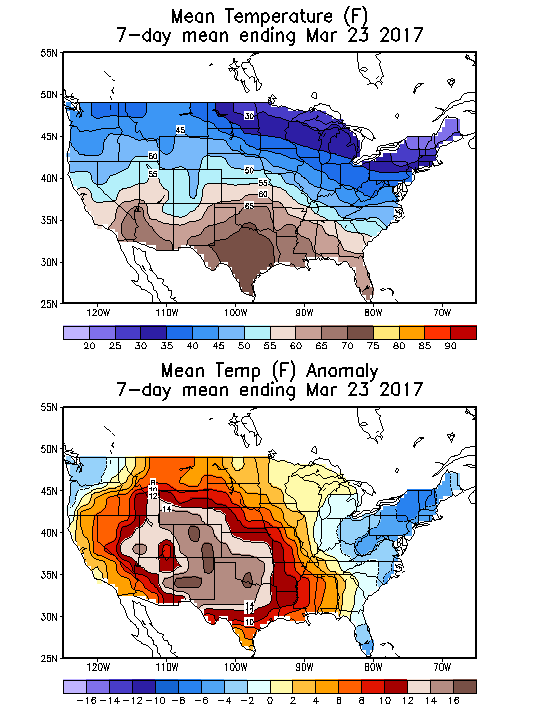
Source: NOAA National Weather Service
Deviation between average and normal (°F)
7-Day Mean ending Mar 23, 2017

Source: NOAA National Weather Service

